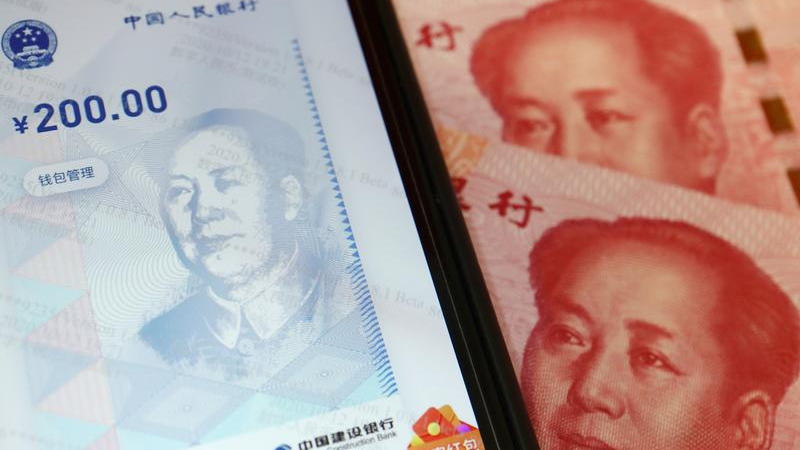
Editor's note: Daryl Guppy is an international financial technical analysis expert. He has provided weekly Shanghai Index analysis for Chinese mainland media for more than a decade. Guppy appears regularly on CNBC Asia and is known as "The Chart Man." He is a national board member of the Australia China Business Council. The article reflects the author's opinions and not necessarily the views of CGTN.
The digital RMB is a central bank digital currency (CBDC) and it is not intended to dethrone the U.S. dollar which dominates the vast global financial markets including stocks, bonds and other financial instruments. However, it is clear that it will displace the U.S. dollar in some transactions and this will reduce the dominant role currently played by the greenback.
In a petty move, some in the U.S. are seeking to ban American athletes from using digital yuan at the Beijing Winter Olympics. It's a move that shows the U.S. fails to understand how the digital yuan is deployed.
Zhou Xiaochuan, the former governor of the People's Bank of China (PBOC), recently said, "China has never aimed to challenge the U.S. dollar's status as the international reserve currency with the development of a digital yuan."
However, China's CBDC will go global in the sense that it will provide an alternative mechanism for cross border trade settlement. The current settlement system is dominated by the SWIFT system. The United States has a chokehold on the Clearing House Interbank Payment System which is used by SWIFT for large U.S. dollar transfers.
This extends the reach of U.S. regulations beyond the statutory borders of the United States. As former U.S. President Trump showed, the U.S. dollar-dominated SWIFT trade settlement system can be weaponized. President Biden has continued down this path and companies doing business with China are increasingly aware of this threat and the way it is used to force compliance with U.S. foreign policy objectives. A unilateral decision taken by U.S. regulators can exclude a non-compliant company from transacting international business in U.S. dollars.
China's case for using the CBDC is that it makes it faster, cheaper, and more convenient to use digital currency for trade with China than the U.S. dollar. China doesn't want to challenge the use of the dollar in broader markets, but as the world's largest exporter, it can convert a growing amount of its trade with the developing world into CBDC transactions. This both reduces its dollar dependence and completes trade settlement without the currency risk and costs inherent in settlement in third party currencies.

China's official app for the digital yuan is seen on a mobile phone next to 100 yuan banknotes in this illustration picture. /Reuters
China's official app for the digital yuan is seen on a mobile phone next to 100 yuan banknotes in this illustration picture. /Reuters
This third-party transfer is no small impost on the cost of doing business. Tourists changing 10,000 of their own currency into U.S. dollars and then immediately converting them back to their home currency end up with less than 10,000 due to currency buy and sell spreads. It's a pittance on a 10,000 transaction but replicate this on national cross border trade settlements and the conversion cost is enormous. Trade settlement in a single CBDC eliminates these currency transfer costs.
The clearest evidence that the PBOC is considering using the digital yuan for international trade comes from the Hong Kong Monetary Authority. Their recent m-CBDC project with the BIS innovation labs, UAE, Thailand and PBOC shows what an interoperable CBDC future might look like. Many analysts believe this project signals China's intent to provide a viable alternative to U.S. dollar-based trade settlement processes.
The digital yuan provides a more efficient alternative to this settlement system. The obvious participants are countries involved in the Belt and Road Initiative and the RCEP partnerships.
The most receptive to these proposals will be countries already involved in BRI projects. This will enable savings on transaction fees because no third-party banking system is involved. It also negates the threat of third-party interference in transactions. The United States has shown its willingness to use the SWIFT system to block cross border trade to achieve U.S. political and foreign policy objectives. The Biden administration has indicated an increased wiliness to use the U.S. dollar settlement system in this way with mooted transaction sanctions against companies it deems are not complying with U.S. policy.
In terms of BRI take-up of the CBDC, there are countries, not only in Asia, but in Africa, Eastern Europe and South America, that are open to the idea of alternatives to an increasingly politicized U.S. dollar trade settlement system.
Many of the RCEP participants are also interested in alternatives to the U.S. dollar-based trade. Already seven of the world's top ten CBDC projects are all China's neighbors or major trading partners. This suggests CBDC will soon be commonly used in trade throughout the region.
Post-World War 2 the U.S. became the world's largest exporter and the U.S. dollar reflected this. China is now the world's largest exporter and it is inevitable that China's CBDC will reflect this status. The CBDC will provide a strong competitive alternative to the U.S. dollar.
(If you want to contribute and have specific expertise, please contact us at opinions@cgtn.com.)

